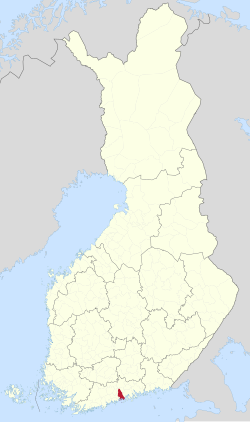Sipoo
Sipoo – Sibbo | |
|---|---|
Municipality | |
| Sipoon kunta Sibbo kommun | |
 Sipoo Old Church | |
 Location of Sipoo in Finland | |
| Coordinates: 60°22.5′N 025°16′E / 60.3750°N 25.267°E | |
| Country | |
| Region | Uusimaa |
| Sub-region | Helsinki sub-region |
| Metropolitan area | Helsinki metropolitan area |
| Charter | 1425 |
| Seat | Nikkilä[1] |
| Government | |
| • Chairman of the municipal board | Eero Seppänen |
| • Chairman of the municipal assembly | Christel Liljeström |
| • Municipal manager | Mikael Grannas |
| Area (2018-01-01)[2] | |
• Total | 698.60 km2 (269.73 sq mi) |
| • Land | 339.66 km2 (131.14 sq mi) |
| • Water | 358.97 km2 (138.60 sq mi) |
| • Rank | 225th largest in Finland |
| Population (2024-10-31)[3] | |
• Total | 22,789 |
| • Rank | 46th largest in Finland |
| • Density | 67.09/km2 (173.8/sq mi) |
| Population by native language | |
| • Finnish | 64.8% (official) |
| • Swedish | 28.1% (official) |
| • Others | 7.1% |
| Population by age | |
| • 0 to 14 | 18% |
| • 15 to 64 | 64.2% |
| • 65 or older | 17.8% |
| Time zone | UTC+02:00 (EET) |
| • Summer (DST) | UTC+03:00 (EEST) |
| Climate | Dfb |
| Website | www |
Sipoo (Finnish pronunciation: [ˈsipoː]; Swedish: Sibbo) is a municipality of Finland. It is part of the Helsinki metropolitan area. The municipality has a population of 22,789 (31 October 2024)[3] and covers an area of 698.60 square kilometres (269.73 sq mi) of which 358.97 km2 (138.60 sq mi) is water.[2] The population density is 67.09 inhabitants per square kilometre (173.8/sq mi). The administrative center of the municipality is Nikkilä (Swedish: Nickby),[1] which is located 34 kilometres (21 mi) northeast of the center of Helsinki. Another significant urban area is Söderkulla, located in the southern part of the municipality.
Sipoo is a bilingual municipality with Finnish and Swedish as its official languages. The population consists of 65% Finnish speakers, 28% Swedish speakers, and 7% speakers of other languages.
The coat of arms of the municipality refers to the origin story of the settlement, according to which the ancestors of Sipoo are said to have arrived in the region on a viking ship, the bow of which was decorated with a head of wolf; accordingly, locals have even been called the “wolves of Sipoo”. The wave lined fess of the coat of arms refers to the Sipoo River.[7][8]
- ^ a b Uusi Nikkilä – Uusi Kaupunki (in Finnish)
- ^ a b "Area of Finnish Municipalities 1.1.2018" (PDF). National Land Survey of Finland. Retrieved 30 January 2018.
- ^ a b "Finland's preliminary population figure was 5,635,560 at the end of October 2024". Population structure. Statistics Finland. 2024-11-19. ISSN 1797-5395. Retrieved 2024-11-22.
- ^ "Population growth biggest in nearly 70 years". Population structure. Statistics Finland. 2024-04-26. ISSN 1797-5395. Retrieved 2024-04-29.
- ^ "Population according to age (1-year) and sex by area and the regional division of each statistical reference year, 2003–2020". StatFin. Statistics Finland. Retrieved 2 May 2021.
- ^ a b "Luettelo kuntien ja seurakuntien tuloveroprosenteista vuonna 2023". Tax Administration of Finland. 14 November 2022. Retrieved 7 May 2023.
- ^ Suomen kunnallisvaakunat (in Finnish). Suomen Kunnallisliitto. 1982. p. 159. ISBN 951-773-085-3.
- ^ "Sisäasiainministeriön vahvistamat kaupunkien, kauppaloiden ja kuntien vaakunat I:13 Sipoo". Kansallisarkiston digitaaliarkisto (in Finnish).[dead link]
